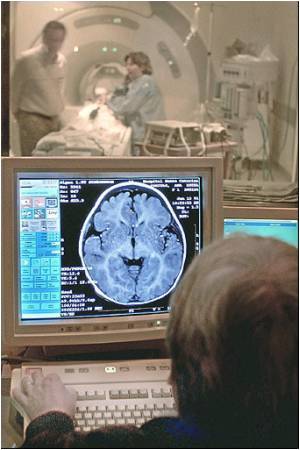Researchers managed to re-establish normal behaviour in mice by applying light stimulation to highly specific neurons in the brain, that had beforehand presented pathological repetitive.

Repetitive behaviour is characterised by a certain number of neuro-psychiatric disorders, in particular obsessive-compulsive disorders, that develop to such an extent that they become a real handicap to daily life (for example, washing hands up to 30 times a day; or checking excessively that a door is locked, etc.). Obsessive-compulsive disorders affect 2 to 3% of the population and in France, it is estimated that over one million persons are affected by this disorder.
The usual treatment for obsessive-compulsive disorders is to use pharmacological treatments (anti-depressants, neuroleptics) and/or behavioural psychotherapy. However, in spite of these therapeutic combinations, severe symptoms persist in around one third of patients. So it is necessary to gain better understanding of the cerebral mechanisms that cause these repetitive behaviour patterns in order to provide better treatment.
Previous neuroimaging studies allowed us to identify dysfunctioning in neuron circuits located between the front of the brain (the orbitofrontal cortex) and more deep-seated cerebral structures (the ganglions at the base on the brain), in certain persons suffering from obsessive-compulsive disorders.
In this new study, Eric Burguière and his co-workers (in the laboratory of Pr. Ann Graybiel in the MIT) concentrated their research on this neuron circuit in order to both examine its function in detail and also to develop an approach to treating obsessive-compulsive disorders in a mutant mouse model.
In these mutant mice, the obsessive behaviour was expressed by repeated grooming all day long, to such an extent that it caused cutaneous lesions. From a physiological point of view, these animals are failing to express a protein (caused by the absence of a gene Sapap3) that is normally present in the stratial neuron synapses, a structure that is part of the ganglions at the base of the brain and is involved in functions such as learning sequences, developing habits, or decision-making.
Advertisement
The use of light
Advertisement
When the researchers used light stimulation to excite the neurons in the cortex that send messages to the striatum, the compulsive disorders of the mice were greatly attenuated. On the other hand, when there was no stimulation, the compulsive behaviour recurred.
"Our discoveries show that selective stimulation of the circuit can re-establish normal behaviour in mice that originally presented pathological repetitive behaviour, similar to the type of behaviour observed in certain patients suffering from obsessive-compulsive disorders", stated Eric Burguière.
This study is promising from a methodological point of view, since it shows that the approach using optogenetics may allow us to identify the role played by neuron circuits in the brain that, if found to be dysfunctional, are liable to cause pathological behaviour.
For researchers, this study has an added interest in the light of its clinical prospects. "I have indeed decided to return to France as part of an Inserm team so that I can run a parallel study on the physiological and behavioural effects of deep cerebral stimulation on patients suffering from obsessive-compulsive disorders, and on mice using the optogenetics technique, in order to get a better understanding of how light stimulation works."
Optogenetics: a recent, highly promising technique
Discovered in the mid 2000's, optogenetics is a technique that combines both optics and genetic engineering. It consists in genetically modifying certain neuron cells to make them sensitive to light. What is the aim of this? The aim is to remotely activate or inhibit a specific sub-population of neurons using a light beam, and, unlike electrical stimulation, to do it without affecting the surrounding cells. What is the purpose? The purpose is to study the causal relationships between the activity of the targeted brain pathways and the behaviour controlled by these.
Source-Eurekalert









